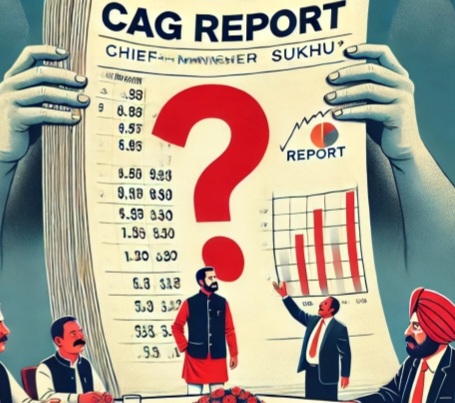Shimla: A deep dive into the CAG 2023-24 report reveals that successive Himachal Pradesh governments have leaned heavily on borrowing sprees, neglecting sustainable avenues for revenue generation.
Despite Chief Minister Sukhvinder Singh Sukhu’s emphatic promises of self-reliance and new revenue measures, the 2025-26 budget—set at Rs 58,356 crore—barely reflects any significant reform.
Borrowing Over Innovation
The CAG 2023-24 report paints a stark picture: instead of channeling efforts into boosting domestic revenue, state governments have repeatedly opted to borrow. In previous fiscal years, the trend was unmistakable.CAG Report Exposes Gaps in Sukhu Govt's ‘Self-Reliant Himachal’ Slogan, Rs 2,795.23 Crore Unaccounted
Chief Minister Sukhvinder Singh Sukhu may have coined the slogan of a self-reliant Himachal, but the Comptroller and Auditor General (CAG) report paints a different picture.
The financial health of the state is under stress, with the government failing to provide utilization certificates (UCs) for projects worth Rs 2,795.23 crore. While the Sukhu government talks about fiscal prudence, the 2025-26 Budget presented in the Vidhan Sabha does little to reflect its much-touted self-reliance mission.
Where Did Rs 2,795 Crore Go?
The CAG report tabled in the assembly revealed that 2,990 utilization certificates were not submitted by various government departments, local bodies, and authorities for funds allocated during 2023-24.
This means there is no clear record of how Rs 2,795.23 crore was spent. The report raises serious questions about transparency and governance under the Sukhu administration.
Adding to the concerns, Rs 1,050.63 crore worth of UCs from the 2022-23 financial year are still pending.
The CAG has strongly flagged this issue, indicating that funds disbursed for developmental schemes may not have been used for the intended purposes.
OPS: A Political Win, but a Financial Burden?
Sukhu’s government implemented the Old Pension Scheme (OPS) from April 1, 2023, a move aimed at winning over state employees. According to government figures, 1,14,544 employees opted for OPS, while only 1,364 remained under NPS. However, the CAG has warned that OPS could become a long-term financial burden on the state, pushing Himachal into deeper fiscal distress.
Disaster Relief Spending: More than Rs 1,200 Crore Spent, But Where?
In 2023, Himachal Pradesh faced severe disasters, prompting the government to spend Rs 1,239.18 crore on relief efforts. Out of this, Rs 1,190.85 crore came from the Centre.
The CAG report states that while the state claimed to have used this amount for disaster mitigation, there is little clarity on the actual utilization.
Sukhu Govt’s Investment Claims Under Scrutiny
The report also highlights the state government’s investments in equity and bonds, which totaled Rs 5,524.23 crore by 2023-24. However, the returns on these investments have been minimal, raising doubts about whether these funds are being parked wisely.
Budget 2025-26: No Roadmap for ‘Self-Reliant Himachal’
While the Sukhu government has been aggressively promoting the ‘self-reliant Himachal’ narrative, the Budget 2025-26 does not reflect any major initiatives to reduce fiscal dependency on the Centre.
Instead, the state continues to rely on central grants, borrowings, and subsidies.
With OPS commitments, unaccounted funds, and increasing debt, the CAG’s findings expose a widening gap between the government's slogans and ground reality.
If transparency and financial accountability are not prioritized, the vision of a self-reliant Himachal may remain just a political catchphrase.
For instance, the 2022-23 period saw a borrowing of over ₹13,000 crore—a strategy that merely postponed fiscal challenges rather than resolving them.
The current report continues this narrative, underscoring a systemic reliance on debt to cover fiscal deficits.
Empty Promises of Self-Reliance
Chief Minister Sukhu has repeatedly touted self-reliance and the promise of new revenue streams to ease the state’s financial burdens.
However, the latest budget for 2025-26 has raised eyebrows among critics and fiscal experts.
The ambitious figure of Rs 58,356 crore was presented in the Vidhan Sabha without a clear roadmap for generating sustainable revenue. The anticipated measures to boost local industries, enhance tax collection, or reduce dependency on central transfers have yet to materialize in measurable financial policies.
Critical Gaps in Fiscal Strategy
The CAG report not only highlights the persistent borrowing spree but also reveals a worrying gap in fiscal discipline.
Excessive Borrowing: Despite clear warnings, the state continues to rely on loans rather than reining in expenditures or innovating new revenue channels.
Revenue Generation Shortfall: Promised initiatives aimed at reducing the fiscal deficit have not translated into robust policy measures, leaving the state’s long-term financial stability in jeopardy.
Budgetary Disconnect: The 2025-26 budget figure, while substantial, is not underpinned by a corresponding increase in revenue-generating strategies, effectively widening the gap between expenditure and income.
Fiscal analysts are increasingly critical of the Sukhu government’s approach. “The reliance on debt as a short-term fix is dangerous,” notes one expert.
“Without proactive measures to enhance revenue—be it through taxation reforms, boosting local enterprise, or innovative public-private partnerships—the state’s economic future remains precarious.”
Critics argue that the budget, though large on paper, masks deep structural issues that could precipitate a severe financial crisis if left unaddressed.
Looking Ahead
With the 2025-26 budget now in the public domain, the pressing question remains: will the Sukhu government pivot from a debt-reliant model to a more balanced, revenue-driven approach?
As Himachal Pradesh’s fiscal health hangs in the balance, voters and policymakers alike are calling for tangible reforms rather than mere rhetoric.
#HimachalCrisis #DebtTrap #RevenueReforms #SukhuGovtUnderFire #BudgetShortfall







